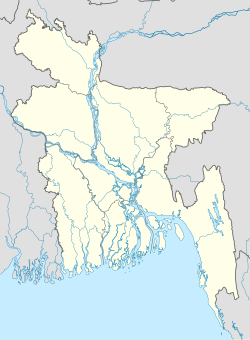Chittagong, Bangladesh
|
Chittagong চট্টগ্রাম Chottogram/ Chatga |
|
|---|---|
| City | |

1. Jamuna Bhaban in Agrabad 2. Ocean City Mall 3. HSBC Chittagong 4. Nasirabad skyline 5. Patenga seafront
|
|
| Nickname(s): Queen of East, City of Twelve Aulias (Bara auliar nagar), Commercial Capital of Bangladesh | |
| Location of Chittagong in Bangladesh | |
| Coordinates: 22°22′N 91°48′E / 22.367°N 91.800°ECoordinates: 22°22′N 91°48′E / 22.367°N 91.800°E | |
| Country |
|
| Division | Chittagong Division |
| District | Chittagong District |
| Establishment | 1340 |
| Granted city status | 1863 |
| Government | |
| • Type | Mayor–Council |
| • Body | Chittagong City Corporation |
| • City Mayor | A J M Nasir Uddin |
| Area | |
| • City | 168.07 km2 (64.89 sq mi) |
| Elevation | 351 metres m (1,152 ft ft) |
| Population (2011) | |
| • City | 2,581,643 |
| • Metro | 4,009,423 |
| • Demonym | Chittagonians |
| Time zone | BST (UTC+6) |
| Postal code | 4000, 4100, 42xx |
| Calling code | 31 |
| Website | Chittagong City Corporation |
Chittagong /tʃɪtəɡɒŋ/ (Bengali: চট্টগ্রাম Bengali pronunciation: [tʃɔt̠t̠ɔgram], Chatga) is a major coastal seaport city and financial centre in southeastern Bangladesh. The city has a population of more than 2.5 million while the metropolitan area has a population of 4,009,423 at the 2011 Census, making it the second largest city in the country. It is the capital of an eponymous district and division. The city is located on the banks of the Karnaphuli River between the Chittagong Hill Tracts and the Bay of Bengal. Much of Chittagong Division is located within the ecological Indo-Burma zone on the boundary of the India Plate and Burma Plate. This makes Chittagong the crossroads of the Indian subcontinent and Southeast Asia. The port city has been known by various names in history, including Chatigaon, Chatigam, Chattagrama, Islamabad, Chattala, Chaityabhumi and Porto Grande De Bengala.
The natural harbour of Chittagong is an ancient gateway to the region of Bengal. It was noted as one of the largest Eastern ports by the Roman geographer Ptolemy in the 1st century. As part of the rich seafaring tradition of the Bengali people, coastal Chittagong was settled and ruled by Indian and Bengali kingdoms. Arab traders saw well-developed currency, banking and shipping in Chittagong during the 9th century. Early cosmopolitan Muslims established dominance over the port as an entrepot of maritime trade, while Arakan, Bengal and Tripura competed for control of the wider hinterland. Muslim conquest took place in the 14th century. Chittagong became the principal port of the Bengal Sultanate. It was used by several leading medieval global explorers, including Ibn Battuta and Niccolò de' Conti. Later, Mrauk U, with assistance from Portuguese trading posts, gained control of the area. The Mughal conquest of Chittagong reestablished Bengali control and ushered an era of stability and trade. The city was renamed as Islamabad. This diverse history is reflected in the rural Chittagonian dialect of Bengali, which has a nearly 50% Arabic-origin vocabulary, as well as Persian and Portuguese loanwords.
...
Wikipedia

